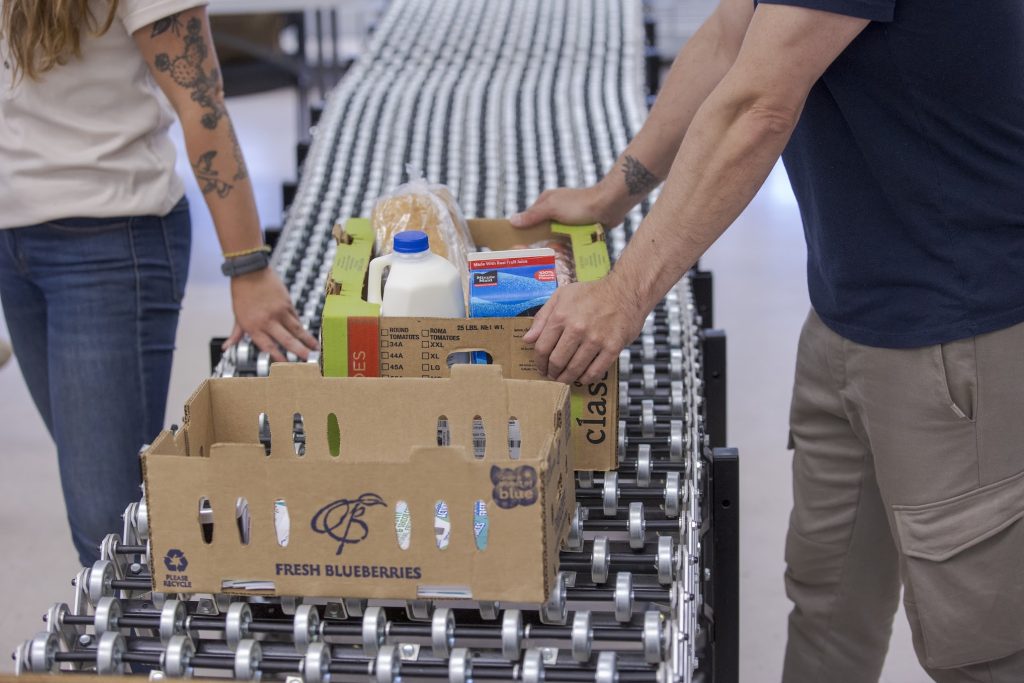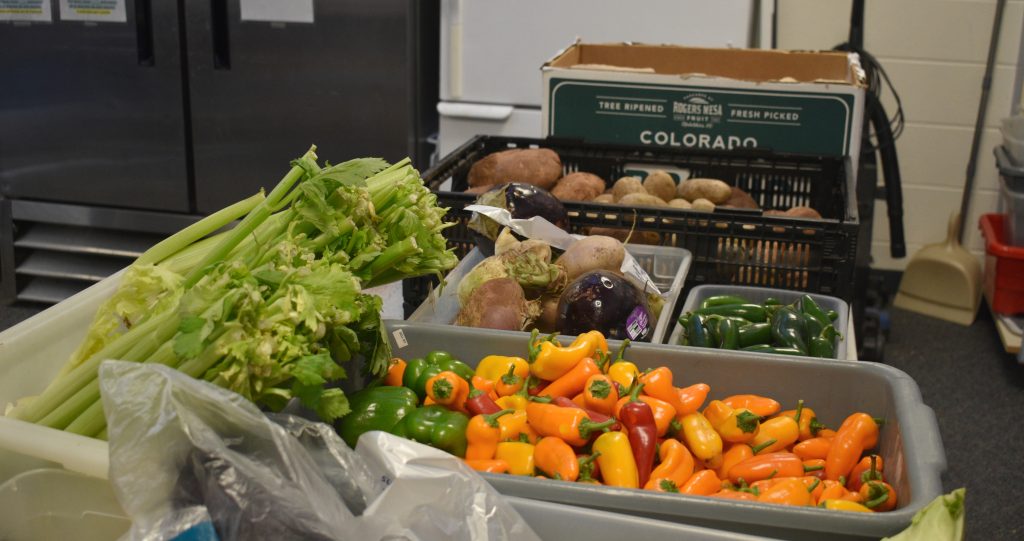Colorado’s rural resort food banks survived the government shutdown. What comes next could be an even greater challenge.
Nonprofit food banks on the Western Slope saw an outpouring of support from their local communities amid November’s SNAP benefit disruptions. Now, they’re operating on a new baseline of demand.
Summit Daily News

Family and Intercultural Resource Center/Courtesy photo
Colorado food banks are still reeling after the end of a 43-day federal government shutdown that pushed the limits of anti-hunger organizations and intensified demand for food assistance across the High Country.
Food providers in mountain towns reported more people coming to their doors at a time when need is already high in their communities. While food banks were largely spared from the initial impacts of the shutdown that began on Oct. 1, as the crisis dragged into November, vital food assistance funding was snarled in government gridlock.
Lapses in benefits for the Supplemental Nutrition Assistance Program at the beginning of the month and mixed messages from the federal government about when payments would be fully restored created uncertainty for the roughly 600,000 Coloradans who rely on the program. Amid what food providers described as a chaotic and uncertain past few weeks, many saw a groundswell of community support that they say was essential to weathering the crisis.
But even with federal government funding now restored and full SNAP payments resuming, anti-hunger advocates say the need isn’t going away.
“I think for us mountain communities, the SNAP pause didn’t create the need, it just exposed how fragile families are here,” said Brianne Snow, executive director for the Intercultural and Family Resource Center in Summit County.
Volunteers, donors step up
As food banks faced a surge in demand, volunteers and donors sprang into action.
Snow’s nonprofit has seen a 30% increase, on average, in the number of people coming to its food pantry so far this month. The resource center typically sees 600-625 households per week in November, but after SNAP benefits lapsed at the start of the month, that figure jumped to around 775 households. Families were also visiting the pantry more frequently, Snow said.
Less scrolling. More knowing.
Sign up for daily or weekly newsletters at SummitDaily.com/newsletter
Volunteers flocked to the nonprofit to help. Snow said on some days, when there would usually be around eight volunteers, she would have 20. Residents would show up for a two-hour shift only to stay for six, and money from donors poured in to help the resource center keep its shelves stocked.
“Without all of this, we simply couldn’t have met demand,” Snow said. “It was really a group effort, but I’ll tell you it was just chaotic.”
Sue Fegelein, executive director of Lift-Up Routt County, which runs two food banks in the Steamboat Springs area, described a frantic lead-up to the SNAP cutoff at the end of October, including meetings with county and school district officials to map out a plan.
That included emergency funding from county officials, which provided up to $60,000 in grocery store gift cards to SNAP-eligible residents, a strategy also deployed by local officials in other mountain counties.
“It was a lot of meetings and planning and prep, which, honestly, kind of brought me back to COVID,” Fegelein said.
In just the first few days of November, Fegelein said her nonprofit saw a 35% increase in customers at its food pantries, and has been providing about 10% to 15% more pounds of food. But financial donations from community members also helped the nonprofit keep up with the pace.
“I had individuals just walk in and hand me checks,” Fegelein said, adding that the nonprofit has seen a doubling so far in monetary donations for November.
In the Roaring Fork Valley, LIFT-UP, a separate nonprofit from the Routt County group, fielded requests from over 500 households, or around 1,550 individuals, during the first two weeks of November. That included 75 first-time customers.
LIFT-UP Interim Executive Director Elyse A. Hottel said a mix of long-term volunteers and new ones helped ensure the nonprofit could get food out to those in need. That included 67 volunteers at its warehouse who packed more than 700 Thanksgiving meal bags in less than three days.

Hottel said the publicity that food insecurity organizations received during the pause in SNAP benefits introduced them to several families who were either unaware of their services or had been deterred by stigma surrounding food pantries. The outpouring of community support, however, had alleviated some of those feelings.
“The community has absolutely risen to the occasion,” Hottel said in an email. “It makes me proud to live here.”
The Eagle Valley Community Foundation, which feeds 4,000 people on average each week, saw a 14% increase in demand during the first two weeks of November, translating into hundreds of additional households, according to Manager of Operations Yulisa Almarez.
The foundation also reported more first-time shoppers and returning families who “had previously stabilized but suddenly found themselves struggling again.”
Harvest for Hunger, which runs self-service pantries in Pitkin County, received permission from the county to operate in its conference center in November, a move that Executive Director Gray Warr said allowed the nonprofit to double its food order from Food Bank of the Rockies.
“(That demand) is only going to go up, and then I think we won’t see a decline until spring,” he said.
Food pantries also received support from the emergency funding requested by Gov. Jared Polis. The legislature’s Joint Budget Committee in October approved up to $10 million for Feeding Colorado, with those funds distributed to local partners as vouchers to help smaller operations purchase food.
Harvest for Hunger received around $3,000-worth of vouchers from Food Bank of the Rockies, while LIFT-UP received around $6,000 in credits for its pantries along the Parachute-to-Aspen corridor. Lift-Up Routt County received over $4,000 in credits.
More challenges on the horizon

As the restoration of SNAP benefits aids some families in a return to normalcy, the same can’t be said for food pantries on Colorado’s Western Slope.
When COVID-19 emergency SNAP allotments ended in 2023, the Eagle Valley Community Foundation saw a 28% increase in visitation, which persisted for months afterward. Almarez said the same will likely play out following the effects of the most recent SNAP disruption, pushing the foundation to operate at a line of demand.
“Even with the government reopened, the Community Market is still serving elevated numbers of families, and we do not anticipate an immediate drop-off. In fact, we’re preparing for sustained strain,” said Grace Anshutz, director of development and marketing for the foundation.
Once a household’s budget collapses, Anshutz said, it often takes time for families to regain stability. Even with November benefits restored, many families are already behind on bills, have depleted savings, or feel uncertain whether their benefits will continue uninterrupted.
Some see the government shutdown as a precursor to even greater challenges.
Hottel, the LIFT-UP interim director, said many of the families who needed help could be at risk of a permanent reduction or even loss of SNAP benefits once federal changes passed under congressional Republicans’ tax and spending cut law go into effect.
Dubbed the One Big Beautiful Bill Act, the measure is set to increase work requirements for SNAP recipients, limit eligibility, freeze potential benefit increases, and cut federal funding by shifting more of the program’s administrative costs to states.
State officials project that those changes could put SNAP benefits at risk for upwards of 80,000 residents and cost Colorado as much as $175 million a year in lost federal funding. Some SNAP changes, like new work requirements, have gone into effect, though potential benefit losses won’t start until 2026. Provisions like the cuts to state funding take effect in 2027.

Rural resort areas already tend to have fewer SNAP recipients compared to other parts of the state, mainly due to factors like higher wages that reflect the elevated cost of living, which make households ineligible. Yet many residents still struggle to afford essentials, from housing to child care, and nonprofit leaders say food is often the first thing they cut to make ends meet.
Snow said there are also other looming cost pressures, like rising health insurance premiums due to the expiration of federal subsidies and cuts to Medicaid included in the tax and spending cut law, that could drive more community members to food pantries.
With sustained demand comes a sustained need for support, especially as food insecurity in the region ramps up ahead of the winter season.
Roughly 29% of respondents to a food insecurity survey conducted by Colorado State University in 2024 said winter is the hardest season for food access, as reflected in the foot traffic food pantries see each year.
Food banks’ higher baseline of demand driven from lingering effects of the government shutdown and a fast-approaching winter will require more stable funding, staffing and volunteer support.

Snow, the director in Summit County, said her nonprofit saw a much-needed boost from community members during the shutdown, but the number of volunteers has since declined. Snow said she’s trying to keep food insecurity at the forefront of everyone’s mind.
“I do worry about sustaining the high number of people coming to the food market as a resource,” Snow said. “There’s been a lot of conversation around using this (current) experience to shape how we show up for the community moving forward.”
With the sustained demand comes a sustained need for support. Food bank leaders say the most effective way community members can help is by making a financial donation. Because food banks can buy food in bulk and at a discount, every dollar donated translates to multiple dollars of purchasing power.
Additionally, monetary gifts allow pantries to stock shelves with the fresh produce, proteins and other items that in-kind donations can’t supply.
“The need is not going away or decreasing, so neither are we,” Hottel said.
Coloradans in need of food resources can reach out to local food banks or community agencies by calling 211, which connects people with state resources such as food assistance. More information can be found by dialing 211 or 866-760-5489, or by visiting 211Colorado.org.

Support Local Journalism

Support Local Journalism
As a Summit Daily News reader, you make our work possible.
Summit Daily is embarking on a multiyear project to digitize its archives going back to 1989 and make them available to the public in partnership with the Colorado Historic Newspapers Collection. The full project is expected to cost about $165,000. All donations made in 2023 will go directly toward this project.
Every contribution, no matter the size, will make a difference.








